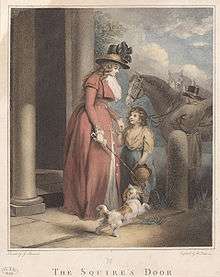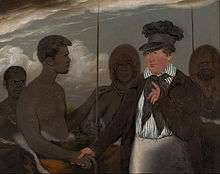Benjamin Duterrau

Benjamin Duterrau (2 March 1768 – 11 July 1851) was an English painter, etcher, engraver, sculptor and art lecturer who emigrated to Tasmania. There he became known for his images of Indigenous people and Australian history paintings.[1]
Career
Duterrau was born in Soho in London, and was of Anglo-French descent. The parish record of Saint Anne, Soho, gives his baptism date as 24 March 1768, father 'Benjamin Dutterreau' and mother 'Sarah'. His father was a watchmaker. Duterrau was apprenticed to an engraver and in 1790 did two coloured stipple engravings after Morland, The Farmer's Door and The Squire's Door. Taking up painting, between 1817 and 1823 he exhibited six portraits at Royal Academy exhibitions, and he also exhibited three genre pieces at the British Institution about the same period.
Duterrau emigrated to Van Diemen's Land (now Tasmania), arriving in August 1832 with his daughter. He lived at the corner of Campbell and Patrick Streets in Hobart, and practised as a portrait painter. In 1835 he did some etchings of Indigenous Australians, the first examples of that craft to be done in Australia. His most famous painting "The Conciliation" is in the Tasmanian Museum and Art Gallery in Hobart with a self-portrait and other works, including some modelling in relief. A large landscape is in the Beattie collection at Launceston, and he is also represented in the Dixon collection at Sydney. Duterrau died at Hobart in 1851.
Duterrau's gravestone lies in Hobart's Tasmanian Museum and Art Gallery, which erroneously names 'Bengamin Duterrau'. The spelling of Benjamin is the same in English and French but the sounds of the letters being spelled is different. Duterrau, though born in London, was the son of immigrant French parents whose first language would have been French and his education and language at home may well have been largely in French. This author suggests that the misspelling on his gravestone is the result of a spelling by either a French speaker to an English speaker or that Duterrau had always spelled his name to people in French alphabet where the English 'G' is pronounced 'jay' in French and 'J' as 'gee'.
Family
His daughter Jane (1812–1885) married John Bogle (1808–1879), a colonial merchant, in Hobart, Tasmania in February 1838, before returning to Britain.[2] Their son Adam played for the Royal Engineers in the 1872 FA Cup Final.
Gallery
-

Edith, Mrs George Gatehouse (c. 1834)
-

Timmy, a Tasmanian Aboriginal, throwing a spear (1838)
-

Mr Robinson's first interview with Timmy (1840)
-

Jack, a Tasmanian Aboriginal, holding a club (1841)
-

Manalagana
-

Mr Robinson on his conciliation mission
References
- ↑ Benjamin Duterrau (National Gallery of Australia)
- ↑ "Benjamin Duterrau". www.arcadja.com. Retrieved 18 February 2015.
- Serle, Percival (1949). "Duterreau, Benjamin". Dictionary of Australian Biography. Sydney: Angus and Robertson. Retrieved 2008-10-05.
- Record for 1768 baptism of 'Benjamin Dutterreau' in Westminster, London. Batch No: CO62369. (International Genealogical Index)
External links
| Wikimedia Commons has media related to Benjamin Duterrau. |
- G. Duterreau (Dictionary of Australian artists online)
- Benjamin Duterrau (ArtNet.com)
- G.A. Robinson with a group of Van Diemen's Land natives' (1835 drawing)
- Mr Robinson's first interview with Timmy (1840, oil on canvas - National Gallery of Australia)
- Native taking a kangaroo (1837, oil on canvas - National Gallery of Australia)